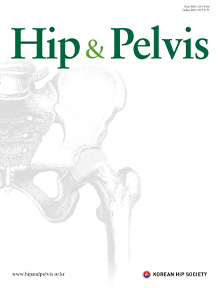Quick links
Related article in
-
Original ArticleDecember 31, 2015
 0
0
 63
63
 15
15

Does the Time of Postoperative Bisphosphonate Administration Affect the Bone Union in Osteoporotic Intertrochanteric Fracture of Femur?
Yoon Je Cho, MD, Young Soo Chun, MD*, Kee Hyung Rhyu, MD*, Joon Soon Kang, MD†, Gwang Young Jung, MD, Jun Hee Lee, MD
Hip Pelvis 2015; 27(4): 258-264AbstractPurpose: This study was designed to investigate the effect of bisphosphonate administration starting time on bone healing and to identify the best administration time following surgical treatment of osteoporotic intertrochanteric fractures.
Materials and Methods: Two hundreds and eighty four patients (284 hips; 52 males, 232 females) who underwent surgery following osteoporotic intertrochanteric fracture from December 2002 to December 2012 were retrospectively analyzed. The average follow-up period was 68.4 months. The patients were divided into three groups according to the time of bisphosphonate administration after operation: 1 week (group A; n=102), 1 month (group B; n=89), and 3 months (group C; n=93). Koval scores and change of Koval scores 1 year after operation were used for clinical evaluation. For radiologic evaluation, the time of callus appearance across the fracture line on sagittal and coronal radiographs and the time to absence of pain during hip motion was judged as the time of bone union.
Results: Koval scores one year after surgery for groups A, B, and C were 2.44, 2.36, and 2.43 (P=0.895), respectively. The mean time of union was 12.4, 11.9, and 12.3 weeks after operation in the three groups (P=0.883), respectively. There were zero cases of nonunion. There were 3, 5, and 7 cases of fixative displacement in the three groups, respectively, but the distribution showed no significant difference (P>0.472).
Conclusion: The initiating time of bisphosphonate administration following surgery does not affect the clinical outcomes in patients with osteoporotic intertrochanteric fracture. -
Original ArticleSeptember 30, 2018
 0
0
 75
75
 18
18

Local Postoperative Complications after Surgery for Intertrochanteric Fractures Using Cephalomedullary Nails
Keong-Hwan Kim, MD, Kye Young Han, MD, PhD
Hip Pelvis 2018; 30(3): 168-174 , Keun Woo Kim, MD, PhD, Jun Hee Lee, MD, Myung Ki Chung, MDAbstractPurpose: Cephalomedullary nails (CMN) are commonly used for the surgical treatment of intertrochanteric fractures. This study aimed to evaluate overall postoperative local complications by reviewing patients who received surgical treatment using three different types of implants.
, Keun Woo Kim, MD, PhD, Jun Hee Lee, MD, Myung Ki Chung, MDAbstractPurpose: Cephalomedullary nails (CMN) are commonly used for the surgical treatment of intertrochanteric fractures. This study aimed to evaluate overall postoperative local complications by reviewing patients who received surgical treatment using three different types of implants.
Materials and Methods: The study sample included 353 patients (107 males, 246 females) who underwent surgery using CMN for intertrochanteric fractures. Three different types of implants were used: i) the Gamma3® (Stryker) in 80 cases, ii) the Targon® PF (Aesculap) in 225 cases, and iii) the Compression Hip Nail® (Trademedics) in 48 cases. The mean age was 82.6 (range, 60-109) years and the average follow-up period was 15 (range, 6-80) months. Postoperative local complications and risk factors of cut-out were assessed.
Results: The most common complication was cut-out (n=26). Other complications included non-union (n=3), periprosthetic fracture (n=2), avascular necrosis (n=1), heterotopic ossification (n=1), and sleeve pull out (n=1). Multivariate analysis revealed that the cut-out group had a higher rate of poor reduction compared to the non-complicated group (P<0.001). Although the mean tip-apex distance (TAD) was 18.4 mm in the non-complicated group, lower than that of the cut-out group (P=0.001), multivariate analysis revealed that TAD was not a significant risk factor for cut-out (P=0.065).
Conclusion: Cut-out is the most common local complication associated with surgical treatment of intertrochanteric fractures using CMN. Proper reduction appears to be important in lowering the risk of cut-out. Maintaining low TAD is another critical factor in achieving sufficient fixation of lag screw to the subchondral bone of the femoral head. -
Original ArticleDecember 31, 2018
 0
0
 84
84
 25
25

Outcomes of Internal Fixation with Compression Hip Screws in Lateral Decubitus Position for Treatment of Femoral Intertrochanteric Fractures
Cheon-Gon Park, MD, Taek-Rim Yoon, MD, Kyung-Soon Park, MD
Hip Pelvis 2018; 30(4): 254-259 AbstractPurpose: Internal fixation using compression hip screws (CHS) and traction tables placing patients in the supine position is a gold standard option for treating intertrochanteric fractures; however, at our institution, we approach this treatment with patients in a lateral decubitus position. Here, the results of 100 consecutive elderly (i.e., ≥45 years of age) patients who underwent internal fixation with CHS in lateral decubitus position are analyzed.
AbstractPurpose: Internal fixation using compression hip screws (CHS) and traction tables placing patients in the supine position is a gold standard option for treating intertrochanteric fractures; however, at our institution, we approach this treatment with patients in a lateral decubitus position. Here, the results of 100 consecutive elderly (i.e., ≥45 years of age) patients who underwent internal fixation with CHS in lateral decubitus position are analyzed.
Materials and Methods: Between March 2009 and May 2011, 100 consecutive elderly patients who underwent internal fixation with CHS for femoral intertrochanteric fracture were retrospectively reviewed. Clinical outcomes (i.e., Koval score, Harris hip score [HHS]) and radiographic outcomes (i.e., bone union time, amount of sliding of lag screw, tip-apex distance [TAD]) were evaluated.
Results: Clinical assessments revealed that the average postoperative Koval score decreased from 1.4 to 2.6 (range, 0-5; P<0.05); HHS was 85 (range, 72-90); and mean bone union time was 5.0 (range, 2.0-8.2) months. Radiographic assessments revealed that anteroposterior average TAD was 6.95 (range, 1.27-14.63) mm; lateral average TAD was 7.26 (range, 1.20-18.43) mm; total average TAD was 14.21 (range, 2.47-28.66) mm; average lag screw sliding was 4.63 (range, 0-44.81) mm; and average angulation was varus 0.72° (range, –7.6°-12.7°). There were no cases of screw tip migration or nonunion, however, there were four cases of excessive screw sliding and six cases of varus angulation at more than 5°.
Conclusion: CHS fixation in lateral decubitus position provides favorable clinical and radiological outcomes. This technique is advisable for regular CHS fixation of intertrochanteric fractures. -
Original ArticleMarch 31, 2022
 0
0
 71
71
 21
21

Does Fracture Severity of Intertrochanteric Fracture in Elderly Caused by Low-Energy Trauma Affected by Gluteus Muscle Volume?
Byung-Kook Kim, MD, PhD, Suk Han Jung, MD
Hip Pelvis 2022; 34(1): 18-24 , Donghun Han, MDAbstractPurpose: The aim of this study was to determine whether there is a correlation between the type and stability of intertrochanteric fractures caused by low-energy trauma and gluteus muscle volume.
, Donghun Han, MDAbstractPurpose: The aim of this study was to determine whether there is a correlation between the type and stability of intertrochanteric fractures caused by low-energy trauma and gluteus muscle volume.
Materials and Methods: A total of 205 elderly (>65 years) patients with intertrochanteric fractures caused by low-energy trauma treated from January 2018 to December 2020 were included in this study. The mean age of patients was 81.24 years (range, 65-100 years). Fractures were classified according to the Jensen modification of the Evans classification. The cross-sectional area of the contralateral gluteus muscle (minimus, medius, and maximus) was measured in preoperative axial computed tomography slices. An analysis and comparison of age, body mass index (BMI), weight, height, and the gluteus muscle area in each fracture type group was performed.
Results: In the uni-variable analysis, statistically significant taller height was observed in patients in the stable intertrochanteric fracture (modified Evans 1 and 2) group compared with those in the unstable intertrochanteric fracture (modified Evans 3, 4, and 5) group (P<0.05). In addition, significantly higher BMI-adjusted gluteus muscle area (gluteus muscle area/BMI) was observed for the stable intertrochanteric fracture group compared with the unstable intertrochanteric fracture group except for the BMI-adjusted gluteus minimus area (P=0.112). In multivariable analysis, only the BMI-adjusted gluteus maximus (P=0.042) and total gluteus areas (P=0.035) were significantly higher in the stable group.
Conclusion: Gluteal muscularity around the hip, especially the gluteus maximus, had a significant effect on the stability of intertrochanteric fractures. -
Original ArticleSeptember 30, 2023
 0
0
 191
191
 31
31

Assessing the Necessity of Extra Reduction Aides in Intramedullary Nailing of Intertrochanteric Hip Fractures
John W. Yurek, DO
Hip Pelvis 2023; 35(3): 183-192 , Nikki A. Doerr, MS
, Nikki A. Doerr, MS  , Alex Tang, MD
, Alex Tang, MD  , Adam S. Kohring, DO
, Adam S. Kohring, DO  , Frank A. Liporace, MD
, Frank A. Liporace, MD  , Richard S. Yoon, MD
, Richard S. Yoon, MD  AbstractPurpose: This study aims to determine which intertrochanteric (IT) hip fracture and patient characteristics predict the necessity for adjunct reduction aides prior to prep and drape aiming for a more efficient surgery.
AbstractPurpose: This study aims to determine which intertrochanteric (IT) hip fracture and patient characteristics predict the necessity for adjunct reduction aides prior to prep and drape aiming for a more efficient surgery.
Materials and Methods: Institutional fracture registries from two academic medical centers from 2017-2022 were analyzed. Data on patient demographics, comorbidities, fracture patterns identified on radiographs including displacement of the lesser trochanter (LT), thin lateral wall (LW), reverse obliquity (RO), subtrochanteric extension (STE), and number of fracture parts were collected, and the need for additional aides following traction on fracture table were collected. Fractures were classified using the AO/OTA classification. Regression analyses identified significant risk factors for needing extra reduction aides.
Results: Of the 166 patients included, the average age was 80.84±12.7 years and BMI was 24.37±5.3 kg/m2. Univariate regression revealed increased irreducibility risk associated with RO (odds ratio [OR] 27.917, P≤ 0.001), LW (OR 24.882, P<0.001), and STE (OR 5.255, P=0.005). Multivariate analysis significantly correlated RO (OR 120.74, P<0.001) and thin LW (OR 131.14, P<0.001) with increased risk. However, STE (P=0.36) and LT displacement (P=0.77) weren’t significant. Fracture types 2.2, 3.2, and 3.3 displayed elevated risk (P<0.001), while no other factors increased risk.
Conclusion: Elderly patients with IT fractures with RO and/or thin LW are at higher risk of irreducibility, necessitating adjunct reduction aides. Other parameters showed no significant association, suggesting most fracture patterns can be achieved with traction manipulation alone.
- 1

Vol.36 No.1
Mar 01, 2024, pp. 1~75
Most Keyword
?
What is Most Keyword?
- It is most registrated keyword in articles at this journal during for 2 years.
Most View
-
Pathophysiology and Treatment of Gout Arthritis; including Gout Arthritis of Hip Joint: A Literature Review
Yonghan Cha, MD
Hip Pelvis 2024; 36(1): 1-11 , Jongwon Lee, MD
, Jongwon Lee, MD  , Wonsik Choy, MD
, Wonsik Choy, MD  , Jae Sun Lee, PhD*,†
, Jae Sun Lee, PhD*,†  , Hyun Hee Lee, MD‡
, Hyun Hee Lee, MD‡  , Dong-Sik Chae, MD‡
, Dong-Sik Chae, MD‡ 
-
Treatment of Osteoporosis after Hip Fracture: Survey of the Korean Hip Society
Jung-Wee Park, MD
Hip Pelvis 2024; 36(1): 62-69 , Je-Hyun Yoo, MD*
, Je-Hyun Yoo, MD*  , Young-Kyun Lee, MD
, Young-Kyun Lee, MD  , Jong-Seok Park, MD†
, Jong-Seok Park, MD†  , Ye-Yeon Won, MD‡
, Ye-Yeon Won, MD‡ 
Editorial Office
Laboratory tests performed in hip fracture patients. CTX: carboxy-terminal telopeptide of collagen I, PTH: parathyroid hormone, P1NP: procollagen type I N propeptide, U/A: urinalysis.|@|~(^,^)~|@|First-line treatment option for osteoporosis in hip fracture patients. BP: bisphosphonate, PTH: parathyroid hormone, SERM: selective estrogen receptor modulator.|@|~(^,^)~|@|Osteoporosis medication in patients with rebound phenomenon after cessation of denosumab. Ca+Vit. D: calcium and vitamin D, PTH: parathyroid hormone, SERM: selective estrogen receptor modulator.|@|~(^,^)~|@|The most important recognized factor for atypical femoral fracture.|@|~(^,^)~|@|Preferred osteoporosis medications after cessation of bisphosphonate in patients with atypical femoral fracture. PTH: parathyroid hormone, Ca+Vit. D: calcium and vitamin D, SERM: selective estrogen receptor modulator.|@|~(^,^)~|@|Preferred osteoporosis medications in patients with high-risk of atypical femoral fracture. Ca+Vit. D: calcium and vitamin D, SERM: selective estrogen receptor modulator, PTH: parathyroid hormone.
Hip Pelvis 2024;36:62~69 https://doi.org/10.5371/hp.2024.36.1.62
© H&P
© 2024. The Korean Hip Society. Powered by INFOrang Co., Ltd




 Cite
Cite PDF
PDF



